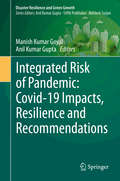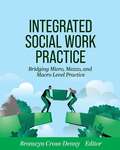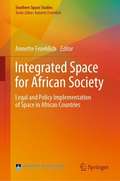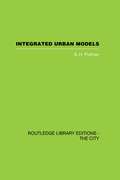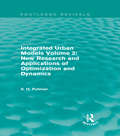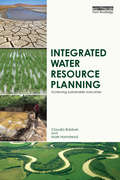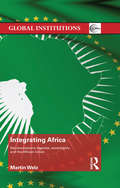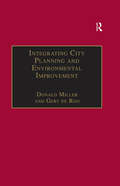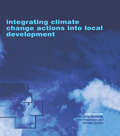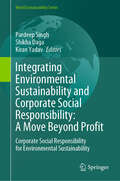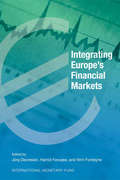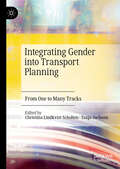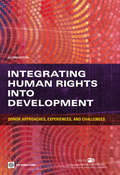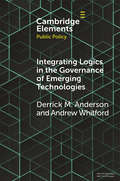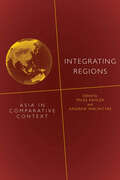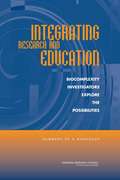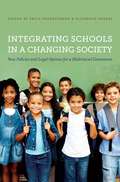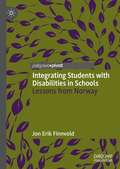- Table View
- List View
Integrated Risk Governance
by Qian Ye Peijun Shi Carlo Jaeger"Integrated Risk Governance: Science Plan and Case Studies of Large-scale Disasters" is the first book in the IHDP-Integrated Risk Governance Project Series. It consists of two parts: Part I: Integrated Risk Governance Project Science Plan, which outlines the challenge, research programme, outcomes, and implementation strategy of the IRG Project; and Part II: Case Studies of Large-scale Disasters, which includes case analyses of experience, lessons learned and recommendations on various large-scale disasters around the world, such as the Tangshan and Wenchuan earthquakes and the great ice storm in China, European heat waves, and Hurricane Katrina in the USA. The community model of integrated natural disaster risk governance and paradigm of catastrophe risk governance in China are also presented. Prof. Peijun Shi works at Beijing Normal University, China; Prof. Carlo Jaeger works at Potsdam Institute for Climate Impact Research, Germany; Prof.Qian Ye works at Beijing Normal University, China.
Integrated Risk of Pandemic: Covid-19 Impacts, Resilience and Recommendations (Disaster Resilience and Green Growth)
by Anil Kumar Gupta Manish Kumar GoyalIn light of the novel corona virus outbreak in December 2019 and its subsequent impact on entire world as a global pandemic, the book attempts to provide integrated risk assessment on Covid -19 like pandemics, as well as to understand the societal, environment and economic impact of the outbreak in various sectors of development. It covers fundamental factors of global disease outbreaks and its coverage as major disaster through the complexity and severity of consequences, illustrating the dimensions of low frequency high intensity disasters. It brings together broad range of topics including basic concepts, isolation measure, role of governance and key technical advancements for containing the diseases. In addition, it also covers resilience analysis towards the impacts such outbreaks have on bio-diversity, ecosystem services and agricultural food production. It defines key exit strategies from the lessons learned and success stories of historical disease outbreaks. The book is presented in four parts, where part 1 familiarizes with fundamentals; part 2 focuses on integrated risk assessments; part 3 focuses on various measures and strategies of resilience; and part 4 suggests key lessons and recommendations. The book is a useful reading reference for scientific community, policy makers and professionals across the domains of health, environment, disasters and sustainable development. Book is specifically beneficial for postgraduate students, researchers, planners and field professionals.
Integrated Social Work Practice: Bridging Micro, Mezzo, and Macro Level Practice
by Bronwyn Cross-DennyFeaturing contributed chapters written by a variety of experts in the field, Integrated Social Work Practice: Bridging Micro, Mezzo, and Macro Level Practice presents vital and contemporary concepts within the discipline as an integrated whole, valuing and examining each topic at the micro through macro level. Section I introduces students to integrated practice, providing a brief history of social work and examining client systems at the micro, mezzo, and macro levels. Section II focuses on the signature pedagogy of fieldwork and includes interprofessional collaboration, and self-care and wellbeing. In Section III, students explore the social work process-from engagement through termination-at all practice levels. Section IV focuses on social justice, including diversity, equity, and inclusion; anti-racism and multicultural competency; intersectionality; practice with aging and LGBTQ+ populations; and human rights. Students focus on topics related to global engagement in Section V. The final section encourages evaluation, self-reflection, and lifelong learning. Individual and group exercises, practice integration examples, In the Field features, and student narratives support the overall learning experience. Presenting students with a cutting-edge approach aligned with building key competencies, Integrated Social Work Practice is an invaluable textbook for B.S.W. and M.S.W. programs and courses.
Integrated Space for African Society: Legal and Policy Implementation of Space in African Countries (Southern Space Studies)
by Annette FroehlichThis book provides an overview of the space sector in African countries, from a legal and policy point of view, analysing how the African Union's Space Policy and Strategy (ASPS) is implemented and highlighting the various space activities in each country. Against this backdrop, it investigates the ASPS, identifying its policy goals identified and discussing its strategy. Moreover, it explores the on-going regional cooperation programmes, the continent's leading space actors and their roles, and the space-related regional fora and organizations, reflecting on various initiatives, including the African Leadership Conference on Space Science and Technology for Sustainable Development (ALC), the Regional African Satellite Communications Organisation (RASCOM), and the African Resource Management Satellite Constellation (ARMS-C). As such, it is a valuable source of information on space capacities in African countries.
Integrated Urban Models Volume 1 (RLE: The City): New Research And Applications Of Optimization And Dynamics
by S. H. PutmanThis book was first published in 1983.
Integrated Urban Models Volume 2: New Research and Applications of Optimization and Dynamics (Routledge Revivals)
by Stephen H. PutmanFollowing on from Integrated Models Volume 1: Policy Analysis of Transportation and Lane Use (Routledge Library Editions, 2006), this book bridges the gap between the scholars and the practitioners of transportation and land-use modelling. First published in 1991, chapters discuss model-calibration and model-solution problems, describe a series of numerical and policy analyses, and propose potential directions for location and land-use research. This reissue will be of particular value to undergraduate and postgraduate geography students with an interest in integrated urban modelling; in particular, the research conducted in the field over the past two decades.
Integrated Water Resource Planning: Achieving Sustainable Outcomes
by Claudia Baldwin Mark HamsteadIntegrated Water Resource Planning provides practical, evidence-based guidance on water resource planning. In a time of heightened awareness of ecosystem needs, climate change, and increasing and conflicting demands on resources, water professionals and decision-makers around the world are on a steep learning curve. This book presents an international examination of water reform experiences, and provides lessons in how to manage environmental uncertainties, long term management, and increase in demand. It breaks the process down into a series of common steps, applies program logic and evaluation theory, and discusses best practices in assessment, decision making and community engagement. Importantly it recognises the large variation in available knowledge and capacity, risk and scale, and discusses a range of approaches that can be used for different circumstances. The book will fill in the gaps for professionals in interdisciplinary teams including sociologists, hydrologists, engineers, ecologists, and community consultation specialists, by providing a basic grounding in areas outside their usual expertise, and will provide ammunition to community stakeholders in their quest to ensure that water planning outcomes are justified and justifiable. Case studies provide an understanding of the context, practical tools and implementation techniques for achieving sustainable outcomes, and the multi-disciplinary approach and insights offered in this book will be transposable and instructive for water professionals worldwide.
Integrated: How American Schools Failed Black Children
by Noliwe RooksA powerful, incisive reckoning with the impacts of school desegregation that traces four generations of the author&’s family to show how the implementation of integration decimated Black school systems and did much of the Black community a disserviceOn May 17, 1954 the landmark case Brown v. Board of Education determined that racial segregation in schools was unconstitutional. Heralded as a massive victory for civil rights, the decision's goal was to give Black children equitable access to educational opportunities and clear a path to a better future. Yet in the years following the ruling, schools in predominantly Black neighborhoods were shuttered or saw their funding dwindle, Black educators were fired en masse, and Black children faced discrimination and violence from their white peers as they joined resource-rich schools that were ill-prepared for the influx of new students.Award-winning interdisciplinary scholar of education and Black history Noliwe Rooks weaves together sociological data and cultural history to challenge the idea that integration was a boon for Black children. She tells the story of her grandparents, who were among the thousands of Black teachers fired following the Brown decision; her father, who was traumatized by his experiences at an almost exclusively-white school; her own experiences moving from a flourishing, racially diverse school to an underserved inner-city one; and finally her son and his Black peers, who over half-century after Brown still struggle with hostility and prejudice from white teachers and students alike. She also shows how present-day discrimination lawsuits directly stem from the mistakes made during integration.At once assiduously researched and deeply engaging, Integrated tells the story of how education has remained both a tool for community progress and a seemingly inscrutable cultural puzzle. Rooks' deft hand turns the story of integration's past and future on it's head, and shows how we may better understand and support generations of students to come.
Integrating Africa: Decolonization's Legacies, Sovereignty and the African Union (Global Institutions)
by Martin WelzThe African Union (AU) is a continental organization that comprises every African state except for Morocco, is indeed a pioneering undertaking. Its ambitious aim is to integrate all member states, with the ultimate goal of forming the United States of Africa. Despite several attempts to build a union, the AU has remained an intergovernmental organization, one reason being a perceived unwillingness of the AU states to pool their national sovereignties. This study seeks to comprehend why Africa’s integration process has not moved towards a supranational organization, using a novel approach. It shifts the usual perspective away from the organization level and provides the first comprehensive and systematic analysis of the AU from the perspective of the states themselves. It includes 8 comprehensive case studies: Algeria, Burkina Faso, Ethiopia, Mauritius, South African, Swaziland, Uganda and Zimbabwe to help understand their foreign policy and provide key insights into why they are (un)willing to yield sovereignty. This work will be of great interest to students and scholars of African politics, international relations and international organizations.
Integrating City Planning and Environmental Improvement: Practicable Strategies for Sustainable Urban Development (Urban Planning and Environment)
by Gert de RooSince Integrating City Planning and Environmental Improvement was originally published in 1999, the practice of integrating urban physical planning and environmental quality management has been widely adopted by governments worldwide. Fully revised and updated with a new preface by editors Donald Miller and Gert de Roo and new figures throughout, this second edition reports on the experience of 23 innovative programmes from 11 countries. Mostly written by practicing planners and government officials, the book looks at a wide range of integrated approaches which have been implemented and the critical assessment of these provides lessons for local and national governments interested in setting up similar schemes and suggesting ways of further innovation. While the Rio Earth summit, Habitat II and Kyoto have been a source of global principles for improving the environmental quality of human settlements, this book explores approaches to implement these policy positions and to make these calls for action operational. Consequently, the presentation of these cases deals not only with the technical aspects of measuring and controlling environmental spillovers, but also with the institutional, political and financial aspects of these programmes.
Integrating Civilian Agencies in Stability Operations
by Terrence K. Kelly Derek Eaton Brooke Stearns Lawson Thomas S. Szayna James E. BarnettHow can the Army help make key civilian agencies more capable partners in stability, security, transition, and reconstruction (SSTR) operations? The authors identify the civilian agencies that should be involved in such operations, then locate the necessary skill sets. They then assess the capacity of the civilian agencies to participate in SSTR operations and analyze the recurring structural problems that have plagued their attempts to do so.
Integrating Climate Change Actions into Local Development
by John Robinson Livia Bizikova Stewart CohenTo date, climate change adaptation and mitigation have been treated separately both in research and in the climate negotiations. However, a growing body of literature is now being developed that points to actual and potential synergies and trade-offs between responses to climate change and sustainability. This literature has evolved in a spontaneous way with diverse approaches and no common methodology to help practitioners explicitly plan for these synergies. This special issue of the Climate Policy journal addresses this gap between scientific knowledge and practitioners' needs by focussing on linkages between climate change and sustainable development at the level of conceptual framework and methods. In particular, the papers address in an integrated way local development options involving both adaptation and mitigation in order to promote resilience to climate change in human and natural systems. The special issue provides policy and methodological guidelines for linking local deveopment pathways with responses to climate change, based on collaboration between local practitioners, the public and scientists.
Integrating Community Engagement in Public Affairs Education: Solutions for Professors Working in Divisive Environments (Routledge Public Affairs Education)
by Thomas Andrew BryerCommunity engaged universities prepare students to participate in societies in ways that are inclusive. This book presents a coherent argument for higher education institutions not only to encourage students to engage in their communities, but also to develop themselves as community engaged institutions. Analyzing the design and implementation of community engaged teaching and learning practices, author Thomas Bryer explores training in democratic practices and envisions a future in which higher education institutions are better prepared to cope with democratic backsliding.Teaching and professional development cases are woven throughout—developed, adapted, and enhanced by the author over a period of years—and grounded in the great debates happening today. Integrating Community Engagement in Public Affairs Education is a culmination of multiple years of experimentation with different approaches to teaching future and practicing public sector leaders the tools of democratic engagement. The text is grounded in a case‑based design that spans undergraduate, Master’s, and Ph.D. students, as well as local government managers, offering concrete examples of teaching and learning strategies that promote public value and measurable social impact. The book closes with practical strategies for publicly engaged scholars to effectively educate the next generation of students about democratic engagement within divided communities. It will be required reading for public administration faculty, as well as practicing public administrators and those who provide training to them.
Integrating Environmental Sustainability and Corporate Social Responsibility: Corporate Social Responsibility for Environmental Sustainability (World Sustainability Series)
by Pardeep Singh Shikha Daga Kiran YadavThis book offers a comprehensive detail about the role that corporate social responsibility can play in promoting sustainable development thereby ensuring a resilient and greener future for all. The book emphasises how business strategies and environmental harmony are becoming more integrated, thereby supporting the agenda towards a sustainable development. The synergistic and symbiotic relationship between social responsibility and sustainability has evolved over the years with enterprises becoming more aware of their commitment towards ethical, equitable, inclusive, and environmentally conscious practices. Adopting a socially responsible attitude by the new age entrepreneurs represents the paradigm shift in how corporations understand and undertake their regular activities. The traditional objective of wealth maximisation that the enterprises followed led to severe misutilisation of resources in terms of its environmental and societal impact and led to severe corporate disasters. It gave rise to adopting alternative objectives that are not only holistic but also combine concern for profits, humanity, society, and, above all, the environment. The result is that almost every major corporation has adopted a code of conduct and established the necessary management structures and procedures to ensure compliance with the newly framed objective of socially responsible profits. Consequently, the concept of corporate social responsibility has acquired momentum in recent times. This has come after the realisation that social responsibility is a significant environmental and organisational sustainability dimension that only some enterprises can sustain for a while. Over the years, this harmonisation has ushered in significant progress, reshaping the perspective of businesses towards their societal and environmental impact.
Integrating Europe's Financial Markets
by Jörg Decressin Hamid Faruqee Wim FonteyneThis publication traces the European Union's journey along the path to a single financial market and identifies the challenges and priorities that remain ahead. It examines recent integration efforts in the EU following the introduction of the euro, the importance of financial integration for economic growth, the interplay between banks and markets, and equity market integration, as well as the relationship between financial integration and financial stability.
Integrating Gender into Transport Planning: From One to Many Tracks
by Christina Lindkvist Scholten Tanja JoelssonThis edited collection brings together feminist research on transport and planning from different epistemologies, with the intention to contribute to a more holistic transport planning practice. With a feminist perspective on transport policy and planning, the volume insists on the political character of transport planning and policy, and challenges gender-blindness in a policy area that impacts the everyday lives of women, men, girls, and boys. The chapters discuss everyday mobility as an embodied and situated activity in both conceptual and theoretical ways and suggest practical tools for change. The contributions of this collection are threefold: integrating gender research and transport planning, combining quantitative and qualitative gender research perspectives and methods, and highlighting the need to acknowledge the politicization of transport planning and transport practice.
Integrating Human Rights into Development
by World Bank OecdThe past two decades have witnessed a convergence between human rights and development, particularly at the level of international political statements and policy commitments. This phenomenon is captured in milestones such as the 2007 OECD DAC Action Oriented Policy Paper on Human Rights and Development (â œAOPPâ ?), the 2010 UN World Summit Outcome Document, the commitments of the 2005 and 2011 High-Level For an Aid Effectiveness in Accra and Busan. The connections between rights violations, poverty, exclusion, environmental degradation, vulnerability and conflict continue to be explored and better understood. More positively, there is growing recognition of the intrinsic importance of human rights in a range of contexts, as well as their potential instrumental relevance for improving development processes and outcomes. This second edition of Integrating Human Rights into Development: Donor Approaches, Experiences and Challenges consolidates the research and findings complied in 2006 with relevant developments that have occurred in the intervening six years. It brings together the key political and policy statements of recent years with a discussion of the approaches and experiences of bilateral and multilateral agencies engaged in integrating human rights in their development cooperation activities in a variety of ways. Despite rapid changes in the donor landscape and acute budget pressures resulting from the financial crisis, the experience of the past six years also attests to the sustained commitment of OECD member countries and multilateral donors to engage with human rights strategically, as a means for improving the ways they deliver and manage aid and the quality of development co-operation.
Integrating Logics in the Governance of Emerging Technologies: The Case of Nanotechnology (Elements in Public Policy)
by Derrick Mason Anderson Andrew WhitfordThe governance of emerging technologies does not follow a single governance paradigm because of complex interactions between government, industry, and civil actors. In this Element, we will argue that for emerging technologies, governance is a 'convergent paradigm'. We introduce governance issues associated with emerging technologies generally before turning to the specifics of nanotechnology. We then approach governance theory and practice by considering different perspectives on governance by their different orientations with respect to object and process. Finally, we construct a matrix of object and process oriented governance activities observed in the case of nanotechnology in the United States.
Integrating Regions: Asia in Comparative Context
by Andrew Macintyre Miles KahlerThe proliferation of regional institutions and initiatives in Asia over the past decade is unmatched in any other region of the world. The authors in this collection explore the distinctive features of these institutions by comparing them for the first time to the experience of other regions; from the elaborate institution-building of Europe to the more modest regional projects of the Americas. It is an opportune moment for this reassessment, as the European regional model faces a sovereign debt crisis while Asian economies see more secure sources of growth from their immediate neighbors. Asias regional institutions display a distinctive combination of decision rules, commitment devices, and membership practices, shaped by underlying features of the region, the dynamics of regional integration, and the availability of institutional substitutes. Within this context, the authors propose changes that will better sustain the prosperity and peace that have marked Asia in recent decades.
Integrating Research And Education: Biocomplexity Investigators Explore The Possibilities
by Bridget K. B. AvilaThe workshop summary provides guidance for researchers applying to the National Science Foundation (NSF) for funding. New NSF guidelines require applications to address the "broader impact" of the proposed research. Presentations at the workshop provided ideas on how to do this by engaging in undergraduate education, K-12 education or public outreach via museums or journalists. The workshop summary discusses issues to consider in choosing an appropriate collaborator for the education or outreach component of the project and how to build in methods for assessing the success of the project. It also provides lists of resources helpful in writing education proposals and discusses the similarities between research in education and scientific research.
Integrating Schools in a Changing Society
by Erica Frankenberg Elizabeth DebrayIn this comprehensive volume, a roster of leading scholars in educational policy and related fields offer eighteen essays seeking to illuminate new ways for American public education to counter persistent racial and socioeconomic inequality in our society. Contributors to Integrating Schools in a Changing Society draw on extensive research to reinforce the key benefits of racially integrated schools, examine remaining options to pursue multiracial integration, and discuss case examples that suggest how to build support for those efforts.
Integrating Science and Politics for Public Health (Palgrave Studies in Public Health Policy Research)
by Adèle Cassola Evelyne De Leeuw Patrick FafardThis open access book bridges the divide between political science and public health, whilst simultaneously embracing the complexities and differences of both. Although public health is inherently political, the tools and insights of political science are often ignored in public health scholarship. Bringing together academics and researchers working at the intersection of both, the book demonstrates how integrating these fields can help reconcile the roles of politics and scientific evidence in policymaking. It also highlights the key conceptual, methodological and substantive implications for bridging this divide, and charts a path forward for a movement towards political science with public health. It will be of interest to academics, researchers and students interested in public health, political science, public policy, and the role of scientific evidence in policymaking.
Integrating Social Media into Information Systems: Requirements, Gaps, and Potential Solutions (G - Reference, Information and Interdisciplinary Subjects)
by Parisa Roshan Isaac R. Porche III Ryan Andrew Brown Astrid Stuth Cevallos Osonde A. Osoba Joshua Mendelsohn Douglas Douglas Yeung John Bordeaux Timothy R. Gulden Laura Kupe Luke J. Matthews Katharine Sieck Sarah SolimanThis report examines the technical challenges associated with incorporating bulk, automated analysis of social media information into procedures for vetting people seeking entry into the United States. The authors identify functional requirements and a framework for operational metrics for the proposed social media screening capabilities and provide recommendations on how to implement those capabilities.
Integrating Southern Europe: EC Expansion and the Transnationalization of Spain
by Otto HolmanIntegrating Southern Europe presents a stimulating comparative analysis of the position of Spain within the European Community and within the global economy. It combines a historical perspective with an analysis of the process of the democratization in Southern Europe and of Spain's increasingly trans-European outlook.
Integrating Students with Disabilities in Schools: Lessons from Norway
by Jon Erik FinnvoldThis book explores the ability of the Norwegian school system to support the achievement of formal competencies among children with physical disabilities, as well as its role in the informal dimensions of social participation and networking. Schools contribute to social inclusion in several ways: they are arenas for building official competencies, ensuring future access and success in the labour market. They are also sites for meeting other children, and developing friendships – friendships are not only important for strengthening cognitive development, but are vital to both good mental health and the building of various forms of social capital. By examining schools and the ways in which inclusion is incorporated early, this book aims to bridge the opportunity and employment gap that people with physical disabilities are more likely to face later in life.

